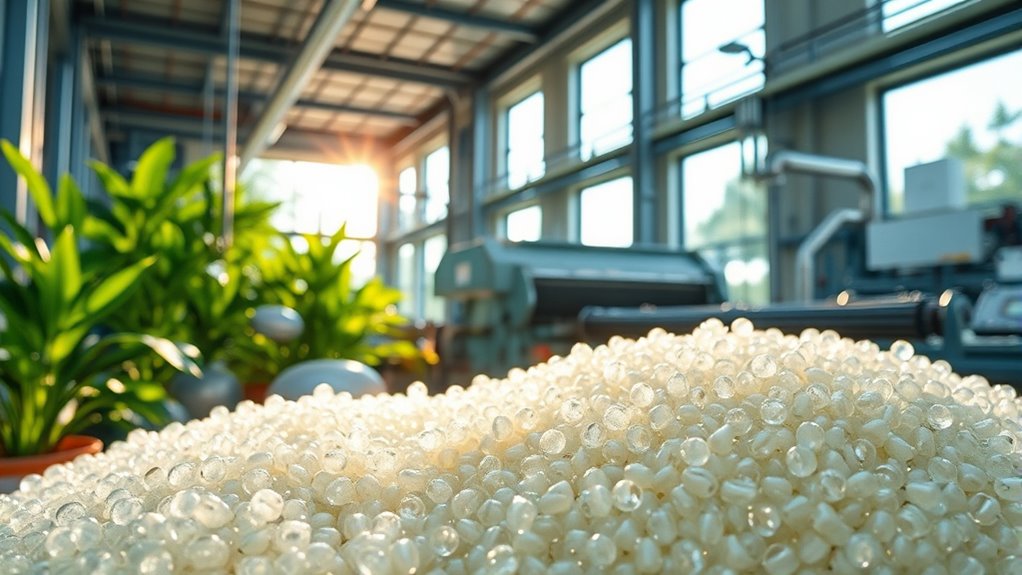Bioplastics like PLA, PHA, and PEF are transforming how industries approach sustainability by offering biodegradable, renewable alternatives to traditional plastics. They are produced from plant-based materials like corn and sugarcane, reducing carbon footprints and helping combat plastic pollution. These materials are increasingly used in packaging, medical devices, and bottles due to their performance and eco-friendly benefits. As their applications expand, understanding their unique advantages can help you see how they’re shaping a greener future.
Key Takeaways
- PLA, PHA, and PEF are emerging bioplastics with diverse applications, driven by environmental benefits and performance improvements.
- These bioplastics are produced from renewable biomass sources like corn and sugarcane, reducing carbon footprints.
- PLA is widely used in packaging and disposable items, while PHA offers biocompatibility for medical uses, and PEF provides superior barrier properties.
- Industry adoption is rapidly growing as companies seek sustainable alternatives to traditional plastics.
- Advancements in high-performance bioplastics are expanding their application scope and accelerating market growth.

Bioplastics like PLA, PHA, and PEF are transforming the way we think about sustainable materials. These innovative plastics are designed to reduce our dependence on traditional petroleum-based products, offering a greener alternative that can substantially lower environmental impact. When you consider their application, you’ll find that they’re not just eco-friendly; they also open new possibilities across various industrial sectors. Their biodegradability means they break down more quickly in natural environments, helping to address the global issue of plastic pollution. This makes them especially appealing for packaging, single-use items, and agricultural films, where reduced waste accumulation is vital. As industries seek sustainable solutions, bioplastics are becoming integral to efforts to minimize ecological footprints.
In terms of environmental impact, bioplastics like PLA, PHA, and PEF stand out because they are produced from renewable biomass sources such as corn, sugarcane, and other plant materials. This renewable origin means their carbon footprint is generally lower compared to traditional plastics, which are derived from fossil fuels. When you use bioplastics, you’re contributing to a cycle that can be closer to carbon neutrality, especially if the raw materials are cultivated sustainably. Furthermore, their ability to biodegrade under specific conditions helps reduce landfill waste and prevents microplastic formation, which is a major concern with conventional plastics. This environmental advantage drives their rapid adoption and encourages industries to integrate these materials into their manufacturing processes. Additionally, advancements in high-performance bioplastics continue to expand their applicability in demanding environments.
Industrial applications of bioplastics are expanding rapidly as well. You’ll find PLA widely used in packaging, disposable tableware, and even in textiles, thanks to its clarity and rigidity. PHA, on the other hand, offers excellent biocompatibility and is increasingly used in medical devices, drug delivery systems, and biodegradable packaging. PEF, a newer bioplastic, boasts superior barrier properties, making it ideal for bottles and containers that require longer shelf life. These applications demonstrate how bioplastics are versatile and can replace traditional plastics in many fields. Their ability to perform well under various conditions makes them attractive to manufacturers looking to meet sustainability goals without sacrificing functionality.
Frequently Asked Questions
How Do Bioplastics Compare in Cost to Traditional Plastics?
Bioplastics currently cost more than traditional plastics, which affects their economic viability and market competitiveness. You’ll notice higher production costs and limited economies of scale, making them less affordable for widespread use. However, as demand grows and technology advances, these costs are expected to decrease. While they might be pricier now, investing in bioplastics can offer long-term benefits, especially as sustainability becomes a priority for consumers and regulators.
Are Bioplastics Suitable for All Types of Packaging?
Bioplastics aren’t suitable for all packaging types because their biodegradability varies, and some lack strong barrier properties. You’ll find they work well for items like food wraps or single-use containers, but not for heavy-duty or long-term packaging. Their biodegradability makes them eco-friendly, but make certain you select a bioplastic with adequate barrier properties for your specific needs to prevent spoilage or contamination.
What Are the Main Challenges in Scaling Bioplastic Production?
Imagine scaling bioplastic production as climbing a steep mountain—challenging but rewarding. You face supply chain hurdles like inconsistent raw material availability and high costs. Technological innovations are your ropes and anchors, helping you overcome these obstacles. To succeed, you must streamline logistics, invest in advanced manufacturing, and foster sustainable sourcing. This journey demands resilience, but with perseverance, you’ll open the full potential of bioplastics for wider adoption and environmental impact.
How Do Bioplastics Impact Recycling Systems?
Bioplastics impact recycling systems by affecting recycling compatibility and posing contamination risks. When you include bioplastics in traditional recycling streams, they can degrade the quality of recycled materials or cause process disruptions. To minimize these issues, separate bioplastics from conventional plastics or develop specific recycling protocols. This way, you help guarantee that bioplastics are recycled efficiently without contaminating other materials, supporting sustainability efforts.
Can Bioplastics Be Used in High-Temperature Applications?
Using bioplastics in high-temperature applications is like trying to use ice for a heated oven—they often lack the necessary thermal stability. Most bioplastics, including PLA, PHA, and PEF, have limited heat resistance and can deform or degrade when exposed to high temperatures. While some advanced formulations are improving, generally, bioplastics aren’t suitable for applications demanding high thermal stability or enduring intense heat.
Conclusion
Think of bioplastics like a garden that’s just beginning to bloom. With PLA, PHA, and PEF as your seeds, you have the power to cultivate a greener future—one where waste transforms into new life, not pollution. As you nurture this garden, remember each choice you make is like watering these plants, helping them grow stronger. Together, we can turn the tide and watch this vibrant ecosystem flourish, shaping a sustainable tomorrow.









